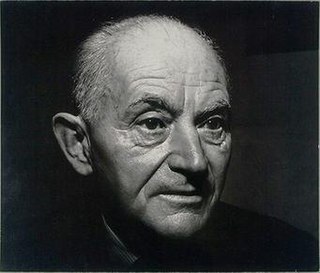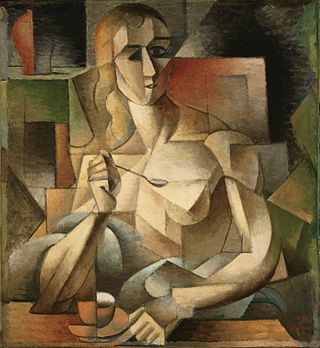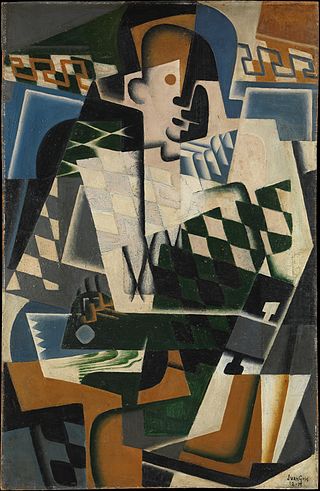
José Victoriano González-Pérez , better known as Juan Gris, was a Spanish painter born in Madrid who lived and worked in France for most of his active period. Closely connected to the innovative artistic genre Cubism, his works are among the movement's most distinctive.

Cubism is an early-20th-century avant-garde art movement begun in Paris that revolutionized painting and the visual arts, and influenced artistic innovations in music, ballet, literature, and architecture. Cubist subjects are analyzed, broken up, and reassembled in an abstract form—instead of depicting objects from a single perspective, the artist depicts the subject from multiple perspectives to represent the subject in a greater context. Cubism has been considered the most influential art movement of the 20th century. The term cubism is broadly associated with a variety of artworks produced in Paris or near Paris (Puteaux) during the 1910s and throughout the 1920s.

Daniel-Henry Kahnweiler was a German-born art collector, and one of the most notable French art dealers of the 20th century. He became prominent as an art gallery owner in Paris beginning in 1907 and was among the first champions of Pablo Picasso, Georges Braque and the Cubist movement in art.

Papier collé is a type of collage and collaging technique in which paper is adhered to a flat mount. The difference between collage and papier collé is that the latter refers exclusively to the use of paper, while the former may incorporate other two-dimension (non-paper) components. As the term papier collé is not commonly used, this type of work is often simply called collage.

The Section d'Or, also known as Groupe de Puteaux or Puteaux Group, was a collective of painters, sculptors, poets and critics associated with Cubism and Orphism. Based in the Parisian suburbs, the group held regular meetings at the home of the Duchamp brothers in Puteaux and at the studio of Albert Gleizes in Courbevoie. Active from 1911 to around 1914, members of the collective came to prominence in the wake of their controversial showing at the Salon des Indépendants in the spring of 1911. This showing by Albert Gleizes, Jean Metzinger, Robert Delaunay, Henri le Fauconnier, Fernand Léger and Marie Laurencin, created a scandal that brought Cubism to the attention of the general public for the first time.

Daniel Vázquez Díaz was a Spanish painter.

María Gutiérrez-Cueto y Blanchard was a Spanish painter. She was known for developing a unique style of Cubism.

Tea Time is an oil painting created in 1911 by the French artist and theorist Jean Metzinger. It was exhibited in Paris at the Salon d'Automne of 1911, and the Salon de la Section d'Or, 1912.

Léonce Rosenberg was an art collector, writer, publisher, and one of the most influential French art dealers of the 20th century. His greatest impact was as a supporter and promoter of the cubists, especially during World War I and in the years immediately after.

Les Peintres Cubistes, Méditations Esthétiques, is a book written by Guillaume Apollinaire between 1905 and 1912, published in 1913. This was the third major text on Cubism; following Du "Cubisme" by Albert Gleizes and Jean Metzinger (1912); and André Salmon, Histoire anecdotique du cubisme (1912).

Lady with a her Dressing Table is a painting by the French artist Jean Metzinger. This distilled synthetic form of Cubism exemplifies Metzinger's continued interest, in 1916, towards less surface activity, with a strong emphasis on larger, flatter, overlapping abstract planes. The manifest primacy of the underlying geometric configuration, rooted in the abstract, controls nearly every element of the composition. The role of color remains primordial, but is now restrained within sharp delineated boundaries in comparison with several earlier works. The work of Juan Gris from the summer of 1916 to late 1918 bears much in common with that of Metzinger's late 1915 – early 1916 paintings.

Crystal Cubism is a distilled form of Cubism consistent with a shift, between 1915 and 1916, towards a strong emphasis on flat surface activity and large overlapping geometric planes. The primacy of the underlying geometric structure, rooted in the abstract, controls practically all of the elements of the artwork.

Still Life with a Poem is an oil painting by Spanish artist Juan Gris, completed in 1915. It is held at the Norton Simon Museum, in Pasadena.

Still Life with Checked Tablecloth is an early 20th century painting by Spanish Cubist artist Juan Gris. Done in oil and graphite on canvas, the painting depicts a table set with grapes, a bottle of red wine, beer, a newspaper and guitar. In addition, the composite image formed from these various objects can be seen as Gris' take on a bull's head. The work is in the collection of the Metropolitan Museum of Art.

Checkerboard and Playing Cards is an early 20th century drawing by Spanish cubist Juan Gris. Done in gouache, graphite, and resin on wove paper, the drawing depicts a table set with a checkerboard and playing cards. Gris' work is in the collection of the Metropolitan Museum of Art, in New York.

Still Life with a Guitar is an oil on canvas painting by Spanish cubist Juan Gris, from 1913. The work is in the collection of the Metropolitan Museum of Art, in New York, Gallery 905.

Violin and Playing Cards on a Table is an oil on canvas painting by Spanish cubist Juan Gris, from 1913. The work is a still life, a typical motif for the cubists. It is in the collection of the Metropolitan Museum of Art, in New York.

Harlequin with a Guitar is an oil on canvas painting by Spanish cubist Juan Gris, from 1917. The work is in the collection of the Metropolitan Museum of Art, in New York.

The Anisette Bottle is a 1914 painting by Juan Gris, now in the Museo Nacional Centro de Arte Reina Sofía in Madrid. It shows a bottle of anisette, specifically the Spanish brand Anís del Mono, with the names of Badalona, Madrid and Paris, all linked with the leaders of the Cubist movement, namely Gris himself, Pablo Picasso and Georges Braque.

The Breakfast is a painting by Juan Gris, painted in October 1915. It is in the collection of the Musée National d'Art Moderne, in Paris, purchased in 1947.




















